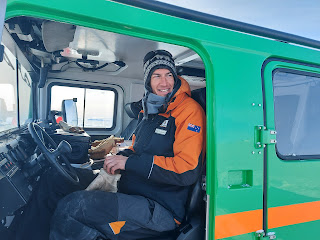We’ve got the science underway!
On one previous occasion, I have arrived in Antarctica ahead of my cargo. However, this is the first time that I've headed out to the field camp while the bulk of our scientific cargo is still sitting in Christchurch.
Moving large volumes of cargo south depends on flights of the US Air Force's C-17s between Christchurch and Phoenix Airfield (~30 mins drive across the ice shelf from McMurdo Station). These military aircraft are capable of shifting people (accommodated with sling seats or palleted airline seats) and/or large items of equipment (I've seen helicopters and D8 bulldozers rolled out of them previously). But they can only do so early or late in the summer season, when the weather is sufficiently cold that the packed snow runway can land them safely. So, the C-17 flights are the main 'airbridge' through September and October.
However, this year only one C-17 was made available for Antarctic service, and it has had a few mechanical issues. So here we are, over two weeks into the science season, and the C-17 has made only one return flight. It is currently in Christchurch awaiting the arrival of a replacement part from the States, along with a specialised crew to make the repair. We have been fortunate that our many smaller items have been transported on either the RNZAF Boeing 757 or the Italian Herc flights that have made it down. But our main consignment of two large boxes (each ~3 cubic metres, and totalling >2 tonne) must wait until the next C-17 flight. Hopefully tomorrow (Monday). Many times, the response to questions between team members begins with "When the cargo arrives…"
While this is a blow to an already disrupted plan, we have been able to adapt our daily activities to take optimal advantage of the equipment and instruments that have arrived. One major win has been to get the EM-31 calibrated and off on its first major deployment – a 30 km skidoo trip around Southern McMurdo Sound. This remarkable instrument can sense the thickness of both the sea ice and the platelet layer from the surface by sending out an ElectroMagnetic (hence the 'EM' in the name) signal. This then stimulates a response EM signal in the sea water which is picked up by a different part of the instrument The differences in time between sending and receiving the signal is translated into thicknesses!
We are hopeful that covering large areas of McMurdo Sound with the EM-31 will tell us more about the unusual sea ice conditions this year – specifically what this means for the distribution, thickness, and functioning of the sub-ice platelet layer. But, for this, we need help from home: the first data file has been sent back to Wolfgang Rack in Christchurch to process into thickness data, and we'll then be able to compare those with our manual measurements as a form of calibration.
Sent from Iridium Mail & Web.
Moving large volumes of cargo south depends on flights of the US Air Force's C-17s between Christchurch and Phoenix Airfield (~30 mins drive across the ice shelf from McMurdo Station). These military aircraft are capable of shifting people (accommodated with sling seats or palleted airline seats) and/or large items of equipment (I've seen helicopters and D8 bulldozers rolled out of them previously). But they can only do so early or late in the summer season, when the weather is sufficiently cold that the packed snow runway can land them safely. So, the C-17 flights are the main 'airbridge' through September and October.
However, this year only one C-17 was made available for Antarctic service, and it has had a few mechanical issues. So here we are, over two weeks into the science season, and the C-17 has made only one return flight. It is currently in Christchurch awaiting the arrival of a replacement part from the States, along with a specialised crew to make the repair. We have been fortunate that our many smaller items have been transported on either the RNZAF Boeing 757 or the Italian Herc flights that have made it down. But our main consignment of two large boxes (each ~3 cubic metres, and totalling >2 tonne) must wait until the next C-17 flight. Hopefully tomorrow (Monday). Many times, the response to questions between team members begins with "When the cargo arrives…"
While this is a blow to an already disrupted plan, we have been able to adapt our daily activities to take optimal advantage of the equipment and instruments that have arrived. One major win has been to get the EM-31 calibrated and off on its first major deployment – a 30 km skidoo trip around Southern McMurdo Sound. This remarkable instrument can sense the thickness of both the sea ice and the platelet layer from the surface by sending out an ElectroMagnetic (hence the 'EM' in the name) signal. This then stimulates a response EM signal in the sea water which is picked up by a different part of the instrument The differences in time between sending and receiving the signal is translated into thicknesses!
We are hopeful that covering large areas of McMurdo Sound with the EM-31 will tell us more about the unusual sea ice conditions this year – specifically what this means for the distribution, thickness, and functioning of the sub-ice platelet layer. But, for this, we need help from home: the first data file has been sent back to Wolfgang Rack in Christchurch to process into thickness data, and we'll then be able to compare those with our manual measurements as a form of calibration.
Sent from Iridium Mail & Web.



Comments
Post a Comment